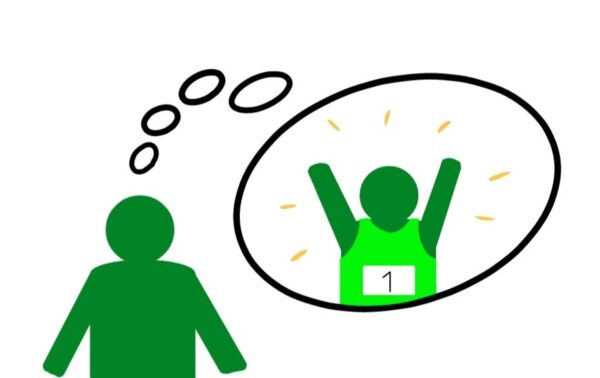MoVo-Strategies
To achieve our health goals, we need effective barrier management (see MoVo process model). This relies on our ability to self-control, which enables us to accomplish what we set out to do in the face of resistance, interruptions, failures, and temptations
Self-control can refer to
- Acute self-control: You pull yourself together and just do it. Example: You get up from the sofa, take your stuff and go, although you are actually tired and would much rather stay at home. This is always necessary when what you have resolved to do contradicts what you would most like to do at the moment. In such situations, it is important to overcome the impulse to avoid effort or fear (inner couch potato!). Different strategies can help , e.g. motivating ourselves with pictures (accentuating positive consequences), putting ourselves in the appropriate mood (mood control), or stopping “dangerous” thoughts. In our intervention programs, we refer to these barrier management strategies as “MoVo-Strategies.” They are presented in more detail below.
- Präventive action control: The new behavior (e.g., a regular visit to the gym or a new diet) is strategically shielded from internal and external barriers. Barrier management is not only used to resist an opposing impulse at a given moment . It is also necessary in order to perform a planned behavior in the long rum (e.g. going for a run every Tuesday and Friday). Long-term strategies of preventive action control are used, e.g. making appointments with others, creating start-off aids, using the power of habit, enjoying successes, looking for role models, organizing support, or giving the project time (see MoVo-Strategies below). Preventive action control knows about the “critical situations” in everyday life and prevents relapse into undesirable behavior patterns.
Ten MoVo strategies for barrier management that are (at least partially) addressed in the various MoVo programs are presented below. Of course, there are many other self-management strategies, so this is only a selection.
The MoVo-Strategies at a glance
- 1. Motivate yourself with images
- 2. Put yourself in the right mood
- 3. Stop dangerous thoughts
- 4. Make appointments with others
- 5. Create start-off aids for yourself
- 6. Use the power of habits
- 7. Enjoy successes
- 8. Look for role models
- 9. Organize support
- 10. Take your time
Strategy 1 – Motivate yourself with images

Use your imagination to get out of a phase of low motivation. Visualization is very effective. Visualize in your mind as vividly as possible what it will be like when you have achieved your goal. For example, imagine how much you will benefit from your training and how great you will feel afterward. Imagine how good it would be if you had already reached your goal and how proud you would be. Such images are enormously powerful. Try to find out which image helps you best.
Strategy 2 – Put yourself in the right mood

There are moods from which it is easy for us to implement our personal plans. We feel energetic and confident. Sometimes, however, we don’t have the slightest desire to implement our plans. For example, when we are exhausted and tired. In such moments, the inner couch potato has lots of control over our behavior. Therefore, make sure that your mood matches the action you are about to take. In this way, you prevent yourself from becoming exhausted to pursue your goal. There are many methods we use in everyday life to influence our moods, such as listening to music to relax or drinking coffee to keep us awake. Another example is, if you are in the process of changing your eating habits, never go grocery shopping hungry. Before any sports appointments, avoid anything that makes you sluggish, such as eating a lot, lying on the sofa or drinking alcohol. Instead, activate yourself by listening to upbeat music or get pumped up with thoughts like, “I’m getting better and better!”. Taking cold showers can also make you active.
Strategy 3 – Stop dangerous thoughts

Your sports appointment is approaching, you should start getting ready to leave now. “What am I eating today? Salty or sweet?” – In the middle of these thoughts, the inner couch potato suddenly creeps in to influence our decisions and behavior. For example: Missing out one appointment doesn’t count! – The others aren’t always there either! – I don’t really miss that much if I´m not going, I can easily make up for it! Be cautious: The termination of your project starts with such thoughts, as it always begins in your head! You can interrupt such thoughts. Say “stop” out loud to yourself. Instead, think about how important exercise – or healthy eating – is for your goals. Address your inner couch potato directly: “No way – I’m doing what I set out to do. Now stop it!” For some people, this thought-stopping method works excellently. Try it out for yourself.
Strategy 4 – Making appointments with others

Loners have to develop their motivation completely from within themselves. If you pursue your goals together with others, it’s often easier to keep it up. This works best with sports but is also possible when it comes to nutrition or relaxation. Arrange with other people when and where you will exercise, cook, or relax together. Such agreements increase your motivation. You commit yourself most effectively when the joint appointment could not take place at all without you – for example, playing tennis with your friend once a week.
Strategy 5 – Create starting aids for yourself

Once you are active, for example in sports, your inner couch potato is usually powerless. Therefore, organize your starting conditions in such a way that you don’t even have to think about whether you should go or not. Your sportswear is already prepared; the bag is packed; you only need to grab all the things and you are ready to go. Before you start cooking a healthy meal, the fresh ingredients are already set on the table, the cookbook is next to it, and you’re ready to start. And of course, you have already been grocery shopping after your last meal.
Strategy 6 – Use the power of habits

Set a fixed date for your intention and use the power of habits. If you are used to doing something, you don’t have to constantly rethink whether you should do it or not. You simply do it. This self-evidence saves a lot of energy. You form a habit particularly effectively if you always do your activity at the same time and in the same place, i.e. in a regular rhythm. For example, every morning before breakfast, do ten minutes of yoga. If you do this often enough, the situation in the morning will literally demand that you do your exercises now. This way, you use the power that comes from the situation itself.
Strategy 7 – Enjoy successes

Nothing motivates you as much as the feeling of success. It is not only important to have success objectively, but also to perceive and experience it consciously. To achieve this, it is not enough to briefly and objectively determine success with our intellect. Rather, it is necessary that we feel it or even better: enjoy it! Only when we really savor our small achievements we can enjoy the motivating effects. Therefore, be aware of every small achievement, and be happy and proud about it. Tell others about them, too. Self-praise is totally okay!
Strategy 8 – Look for role models

Use the motivating power of role models. Look for someone who is a role model to you in terms of sports, nutrition, or relaxation. Maybe even someone who is similar to you and with whom you can identify at certain points. This can be persons from your social environment, but also people you know from the media. Let these role models inspire and encourage you. For example: How did he build his training? How did she deal with her setbacks? How did he motivate himself? Say to yourself: If they can do it, I can do it, too!
Strategy 9 – Organize support

Your partner, friends, or family can also help you to overcome phases with low motivation.
For example, by
- organizational help (“You go to the gym, I’ll do the shopping in the meantime”)
- Consideration (“We’ll wait with dinner until you’re back”)
- Reminding (“We can’t go to the theatre, you have your cooking class there”)
- Encouragement (“Why don’t you go to the gym, it’s good for you!”)
- Encouragement (“You’ve already achieved so much, don’t give up now!”)
- Joining in (“Let’s go for a run together!”).
Talk to your partner about your need for support. If they are couch potatoes themselves or fan of unhealthy eating habits, it will be more difficult. But maybe they can at least be neutral and not stop you from achieving your goals.
Strategy 10 – Take your time

When you ask people why they don’t exercise or do regular relaxation exercises, their answer often sounds something like this: “My job consumes too much time, I don’t have any time left for things like that.” Even when changing your diet, you sometimes have to organize your time differently – for example, to be able to prepare your own meals or eat with pleasure. Whether the time problem can be solved is a question of intelligent time management and the right mental strategies.
Here are some recommendations:
- Schedule: Put your health appointments on the same calendar you use to organize your work appointments.
- Importance: Value your health appointments as much as important professional or personal appointments, such as doctor’s appointments.
- Screen: Declare these appointments as „sacred appointments” that are untouchable to anything or anyone.
